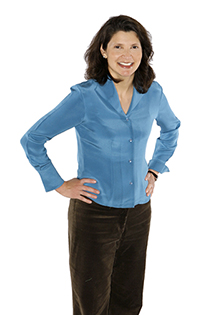
One definition of a luminary is “a person who has attained eminence in his or her field or is an inspiration to others.” Another definition is Monica Martinez-Canales (8964), at least according to the Hispanic Engineers National Achievement Awards Corporation (HENAAC), which presented her with a 2007 Luminary Award on Oct. 12.
The Luminary Award is given to Hispanic professionals in engineering, science, and technology in recognition of significant contributions to the Hispanic technical community. HENAAC expects these individuals to continue to carry the torch at their respective organizations and inspire future generations to pursue careers in technology.
Monica, who was born in Mexico and raised in the toughest barrios of San Diego, was the first member of her extended family to go college. She earned her BS in mathematics from Stanford University and her PhD in numerical analysis from Rice University. She returned to Stanford as a postdoctoral fellow in the Department of Geological and Environmental Sciences. In 2000, she joined Sandia’s Department of Computational Sciences and Mathematics Research.
Throughout college, Monica was considering a career in medicine. She majored in pure mathematics because she enjoyed the subject, but didn’t see a career path outside of academia. Then, in 1991, she attended a conference organized by the Society for the Advancement of Chicanos and Native Americans in Science. She met Richard Tapia, a professor in the Department of Computational and Applied Mathematics at Rice University, and many of his current and former students, which included Mimi Celis, a female mathematician working at SGI, and Juan Meza, previously the manager of Sandia/California’s Computational Sciences and Mathematics Research Department.
Monica says the interaction with Tapia and his students changed her life. “I met these amazing mathematicians who were impacting society at large with their work. I saw that you could apply mathematics to hard problems in national defense, high-performance computing, and visualization,” she says.
She spent the summer of 1992 at Sandia/California as an intern, working under Meza. That fall, she attended Rice as a graduate student. For her PhD thesis, she researched fluid flow problems in an estuary base. She helped develop shallow water models of Galveston Bay that tracked the effects of tidal surges and ocean patterns.
“This was the most interesting work I’d done to that point,” she says. “There was a real environmental interest driving the work, as both shipping tankers and fisherman have a large presence in Galveston Bay.”
The underlying mathematics that Monica developed for the models got significant notice. She was awarded a National Science Foundation postdoctoral fellowship to work with the hydrogeology program at Stanford University.
In 2000, Juan Meza recruited Monica to work at Sandia in his department. From 2003 to 2005, she led her own LDRD project on an innovative new Bayesian-based approach to computational design exploration under uncertainty. In 2003 she was coprincipal investigator of a National Science Foundation grant to fund student scholarships and a doctoral consortium for the 2003 Richard Tapia Celebration of Diversity in Computing Conference.
Monica is passionate about serving as a role model to encourage more women and Hispanics to pursue careers in math and science. She says the number of women and minorities among her peers is less than it should be.
To show the world what is possible, she is involved with numerous organizations for women and minorities in science.
Monica would like to be seen as proof that perseverance and hard work pay off. She understands that as a role model, she serves different purposes to different people. “Some just want to know it’s achievable, others want help with a
specific problem, others want long-term career advice, and others want to know how I got here and how I balance my work and family life,” she says.
That work/family balance question is one Monica is highly qualified to answer — she’s the mother of two young children. As active as her career is, she has an equally full life outside of work. In her “spare” time, she cooks, cleans, bakes, launders, irons, reads novels, sews children’s clothes, makes quilts, grows plants from seed, paints, practices martial arts, and spends time tending her garden.
If she could impart just one lesson to aspiring mathematicians, scientists, or anyone for that matter, it would be that it is okay, even necessary, to ask questions.
“Between junior high school and college, I stopped asking questions,” she says. “It made that part of my education excruciating. You have to learn to find people who will help you. The hardest part is approaching someone. Even now I find myself sitting in my office, not wanting to call someone because I don’t even know what I don’t understand. But if you don’t ask, you can’t learn.”